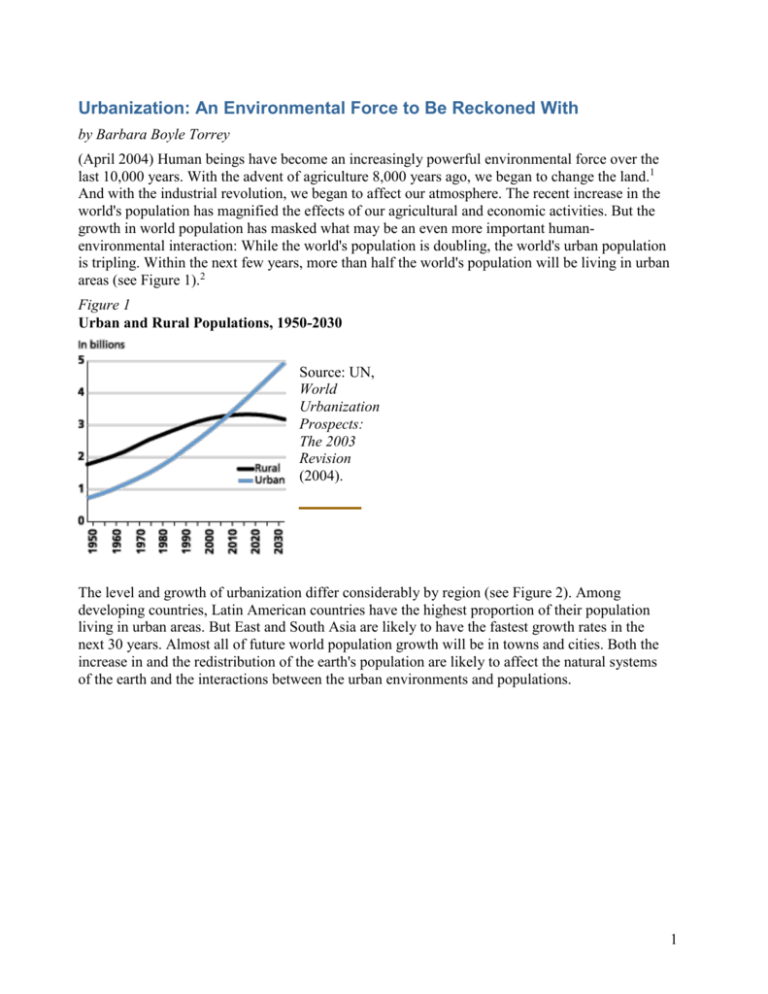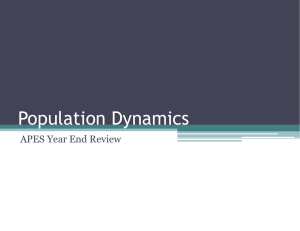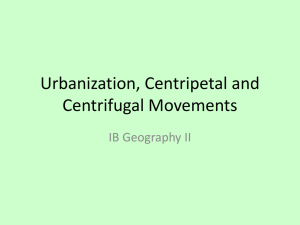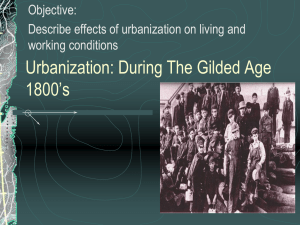
Urbanization: An Environmental Force to Be Reckoned With
by Barbara Boyle Torrey
(April 2004) Human beings have become an increasingly powerful environmental force over the
last 10,000 years. With the advent of agriculture 8,000 years ago, we began to change the land.1
And with the industrial revolution, we began to affect our atmosphere. The recent increase in the
world's population has magnified the effects of our agricultural and economic activities. But the
growth in world population has masked what may be an even more important humanenvironmental interaction: While the world's population is doubling, the world's urban population
is tripling. Within the next few years, more than half the world's population will be living in urban
areas (see Figure 1).2
Figure 1
Urban and Rural Populations, 1950-2030
Source: UN,
World
Urbanization
Prospects:
The 2003
Revision
(2004).
The level and growth of urbanization differ considerably by region (see Figure 2). Among
developing countries, Latin American countries have the highest proportion of their population
living in urban areas. But East and South Asia are likely to have the fastest growth rates in the
next 30 years. Almost all of future world population growth will be in towns and cities. Both the
increase in and the redistribution of the earth's population are likely to affect the natural systems
of the earth and the interactions between the urban environments and populations.
1
Figure 2
Population Living in Urban Areas
Source: UN,
World
Urbanization
Prospects:
The 2003
Revision
(2004).
The best data on global urbanization trends come from the United Nations Population Division
and the World Bank.3 The UN, however, cautions users that the data are often imprecise because
the definition of urban varies country by country. Past projections of urbanization have also often
overestimated future rates of growth. Therefore, it is important to be careful in using urbanization
data to draw definitive conclusions.
The Dynamics of Urbanization
In 1800 only about 2 percent of the world's population lived in urban areas. That was small
wonder: Until a century ago, urban areas were some of the unhealthiest places for people to live.
The increased density of populations in urban areas led to the rapid spread of infectious diseases.
Consequently, death rates in urban areas historically were higher than in rural areas. The only
way urban areas maintained their existence until recently was by the continual in-migration of
rural people.4
In only 200 years, the world's urban population has grown from 2 percent to nearly 50 percent of
all people. The most striking examples of the urbanization of the world are the megacities of 10
million or more people. In 1975 only four megacities existed; in 2000 there were 18. And by 2015
the UN estimates that there will be 22.5 Much of the future growth, however, will not be in these
huge agglomerations, but in the small to medium-size cities around the world.6
The growth in urban areas comes from both the increase in migration to the cities and the fertility
of urban populations. Much of urban migration is driven by rural populations' desire for the
advantages that urban areas offer. Urban advantages include greater opportunities to receive
education, health care, and services such as entertainment. The urban poor have less opportunity
for education than the urban nonpoor, but still they have more chance than rural populations.7
Urban fertility rates, though lower than rural fertility rates in every region of the world, contribute
2
to the growth of urban areas. Within urban areas, women who migrated from rural areas have
more children than those born in urban areas.8 Of course, the rural migrants to urban areas are not
a random selection of the rural population; they are more likely to have wanted fewer children
even if they had stayed in the countryside. So the difference between the fertility of urban
migrants and rural women probably exaggerates the impact of urban migration on fertility.
In sub-Saharan Africa, the urban fertility rates are about 1.5 children less than in rural areas; in
Latin America the differences are almost two children.9 Therefore, the urbanization of the world
is likely to slow population growth. It is also likely to concentrate some environmental effects
geographically.
Environmental Effects of Urbanization
Urban populations interact with their environment. Urban people change their environment
through their consumption of food, energy, water, and land. And in turn, the polluted urban
environment affects the health and quality of life of the urban population.
People who live in urban areas have very different consumption patterns than residents in rural
areas.10 For example, urban populations consume much more food, energy, and durable goods
than rural populations. In China during the 1970s, the urban populations consumed more than
twice as much pork as the rural populations who were raising the pigs.11 With economic
development, the difference in consumption declined as the rural populations ate better diets. But
even a decade later, urban populations had 60 percent more pork in their diets than rural
populations. The increasing consumption of meat is a sign of growing affluence in Beijing; in
India where many urban residents are vegetarians, greater prosperity is seen in higher
consumption of milk.
Urban populations not only consume more food, but they also consume more durable goods. In
the early 1990s, Chinese households in urban areas were two times more likely to have a TV,
eight times more likely to have a washing machine, and 25 times more likely to have a
refrigerator than rural households.12 This increased consumption is a function of urban labor
markets, wages, and household structure.
Energy consumption for electricity, transportation, cooking, and heating is much higher in urban
areas than in rural villages. For example, urban populations have many more cars than rural
populations per capita. Almost all of the cars in the world in the 1930s were in the United States.
Today we have a car for every two people in the United States. If that became the norm, in 2050
there would be 5.3 billion cars in the world, all using energy.13
In China the per capita consumption of coal in towns and cities is over three times the
consumption in rural areas.14 Comparisons of changes in world energy consumption per capita
and GNP show that the two are positively correlated but may not change at the same rate.15 As
countries move from using noncommercial forms of energy to commercial forms, the relative
price of energy increases. Economies, therefore, often become more efficient as they develop
because of advances in technology and changes in consumption behavior. The urbanization of the
world's populations, however, will increase aggregate energy use, despite efficiencies and new
technologies. And the increased consumption of energy is likely to have deleterious
environmental effects.
Urban consumption of energy helps create heat islands that can change local weather patterns and
weather downwind from the heat islands. The heat island phenomenon is created because cities
3
radiate heat back into the atmosphere at a rate 15 percent to 30 percent less than rural areas. The
combination of the increased energy consumption and difference in albedo (radiation) means that
cities are warmer than rural areas (0.6 to 1.3 C).16 And these heat islands become traps for
atmospheric pollutants. Cloudiness and fog occur with greater frequency. Precipitation is 5
percent to 10 percent higher in cities; thunderstorms and hailstorms are much more frequent, but
snow days in cities are less common.
Urbanization also affects the broader regional environments. Regions downwind from large
industrial complexes also see increases in the amount of precipitation, air pollution, and the
number of days with thunderstorms.17 Urban areas affect not only the weather patterns, but also
the runoff patterns for water. Urban areas generally generate more rain, but they reduce the
infiltration of water and lower the water tables. This means that runoff occurs more rapidly with
greater peak flows. Flood volumes increase, as do floods and water pollution downstream.
Many of the effects of urban areas on the environment are not necessarily linear. Bigger urban
areas do not always create more environmental problems. And small urban areas can cause large
problems. Much of what determines the extent of the environmental impacts is how the urban
populations behave — their consumption and living patterns — not just how large they are.
Health Effects of Environmental Degradation
The urban environment is an important factor in determining the quality of life in urban areas and
the impact of the urban area on the broader environment. Some urban environmental problems
include inadequate water and sanitation, lack of rubbish disposal, and industrial pollution.18
Unfortunately, reducing the problems and ameliorating their effects on the urban population are
expensive.
The health implications of these environmental problems include respiratory infections and other
infectious and parasitic diseases. Capital costs for building improved environmental infrastructure
— for example, investments in a cleaner public transportation system such as a subway — and for
building more hospitals and clinics are higher in cities, where wages exceed those paid in rural
areas. And urban land prices are much higher because of the competition for space. But not all
urban areas have the same kinds of environmental conditions or health problems. Some research
suggests that indicators of health problems, such as rates of infant mortality, are higher in cities
that are growing rapidly than in those where growth is slower.19
Urban Environmental Policy Challenges
Since the 1950s, many cities in developed countries have met urban environmental challenges.
Los Angeles has dramatically reduced air pollution. Many towns that grew up near rivers have
succeeded in cleaning up the waters they befouled with industrial development. But cities at the
beginning of their development generally have less wealth to devote to the mitigation of urban
environmental impacts. And if the lack of resources is accompanied by inefficient government, a
growing city may need many years for mitigation. Strong urban governance is critical to making
progress. But it is often the resource in shortest supply.20 Overlapping jurisdictions for water, air,
roads, housing, and industrial development frustrate efficient governance of these vital
environmental resources. The lack of good geographic information systems means that many
public servants are operating with cataracts. The lack of good statistics means that many urban
indicators that would inform careful environmental decisionmaking are missing.21
When strong urban governance is lacking, public-private partnerships can become more
4
important.22 These kinds of partnerships can help set priorities that are shared broadly, and
therefore, implemented. Some of these public-private partnerships have advocated tackling the
environmental threats to human health first. "Reducing soot, dust, lead, and microbial disease
presents opportunities to achieve tangible progress at relatively low cost over relatively short
periods," concluded conferees at a 1994 World Bank gathering on environmentally sustainable
development.23 But ultimately there are many other urban environmental priorities that produce
chronic problems for both people and the environment over the long term that also have to be
addressed.
Much of the research that needs to be done on the environmental impacts of urban areas has not
been done because of a lack of data and funding. Most of the data that exist are at a national level.
But national research is too coarse for the environmental improvement of urban areas. Therefore,
data and research at the local level need to be developed to provide the local governments with
the information they need to make decisions. Certainly the members of the next generation, the
majority of whom will be living in urban areas, will judge us by whether we were asking the right
questions today about their urban environments. They will want to know whether we funded the
right research to address those questions. And they will also want to know whether we used the
research findings wisely.
Barbara Boyle Torrey is a writer and consultant who serves on PRB's board of trustees.
References
1. M. Gordon Wolman, "Population, Land Use, and Environment: A Long History," in
Population and Land Use in Developing Countries, ed. Carole L. Jolly and Barbara Boyle
Torrey, Committee on Population, Commission on Behavioral and Social Sciences and
Education, National Research Council (Washington, DC: National Academies Press,
1993).
2. United Nations, World Urbanization Prospects: The 2003 Revision (New York: UN,
2004).
3. World Bank, World Development Report 2002: Building Institutions for Markets (New
York: Oxford University Press for the World Bank, 2002).
4. Nathan Keyfitz, "Impact of Trends in Resources, Environment and Development on
Demographic Prospects," in Population and Resources in a Changing World, ed. Kingsley
Davis et al. Stanford, CA: Morrison Institute for Population and Resource Studies, 1989).
5. United Nations, World Urbanization Prospects.
6. National Research Council, Cities Transformed: Demographic Change and Its
Implications in the Developing World, ed. Mark R. Montgomery et al., Panel on Urban
Population Dynamics, Committee on Population, Commission on Behavioral and Social
Sciences and Education, National Research Council (Washington, DC: National
Academies Press, 2003).
7. United Nations, World Urbanization Prospects: 193.
8. Martin Brockerhoff, "Fertility and Family Planning in African Cities: The Impact of
5
Female Migration," Journal of Biosocial Science 27, no. 3 (1995): 347-58; and Robert
Gardner and Richard Blackburn, "People Who Move: New Reproductive Health Focus,"
Population Reports Vol. 24, no. 3 (Baltimore, MD: Johns Hopkins School of Public
Health, Population Information Program, November 1996).
9. Estimates calculated from 90 Demographic and Health Surveys as reported in National
Research Council, Cities Transformed: Demographic Change and Its Implications in the
Developing World.
10. Jyoti K. Parikh et al., Indira Gandhi Institute of Development Research, "Consumption
Patterns: The Driving Force of Environmental Stress" (presented at the United Nations
Conference on Environment and Development, August 1991).
11. Jeffrey R. Taylor and Karen A. Hardee, Consumer Demand in China: A Statistical
Factbook (Boulder, CO: Westview Press, 1986): 112.
12. Taylor and Hardee, Consumer Demand in China: 148.
13. U.S. Census Bureau, Statistical Abstract of the United States: 2003 (Washington, DC:
Government Printing Office, 2003).
14. Taylor and Hardee, Consumer Demand in China: 125.
15. Gretchen Kolsrud and Barbara Boyle Torrey, "The Importance of Population Growth in
Future Commercial Energy Consumption," in Global Climate Change: Linking Energy,
Environment, Economy and Equity, ed. James C. White (New York: Plenum Press, 1992):
127-42.
16. Andrew S. Goudie, The Human Impact on the Natural Environment, 2d ed. (Cambridge,
MA: MIT Press, 1987): 263.
17. Goudie, The Human Impact on the Natural Environment: 265.
18. Kolsrud and Torrey, "The Importance of Population Growth in Future Commercial
Energy Consumption": 268.
19. Martin Brockerhoff and Ellen Brennan, "The Poverty of Cities in Developing Regions,"
Population and Development Review 24, no. 1 (March 1998): 75-114.
20. Eugene Linden, "The Exploding Cities of the Developing World," Foreign Affairs 75, no.
1 (1996): 52-65.
21. Organisation of Economic Co-operation and Development (OECD), Better Understanding
Our Cities, The Role of Urban Indicators (Paris: OECD, 1997).
22. Ismail Serageldin, Richard Barrett, and Joan Martin-Brown, "The Business of Sustainable
Cities," Environmentally Sustainable Development Proceedings Series, no. 7
(Washington, DC: The World Bank, 1994).
23. Serageldin, Barrett, and Martin-Brown, "The Business of Sustainable Cities": 33.
Copyright 2006, Population Reference Bureau. All rights reserved.
6









